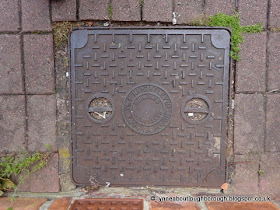So, a quick look at the similarities between Launceston - which was where we broke our long journey - and Loughborough. Both were small market towns, both played a part in the Civil War.
 |
| Costume in Launceston Museum |
 |
| Launceston Museum |
 |
| Costumed mannequin at one time in the Old Rectory Museum |
The War Memorial in Launceston rises up in the centre of the town, unlike ours which is in the beautiful setting of Queen's Park, and is now accompanied by a memorial to Loughborough's war horse, Songster.
The town hall clock in Loughborough is pretty special: the clock I spotted in Launceston was attached to a bank building, and was rather ornate:
Both towns had a workhouse. Loughborough's first was on the site now occupied by the Royal Mail sorting office. The Union workhouse was situated on what is now Regent Street. I've posted before about Loughborough's Workhouse, so here's some information about Launceston's:
Now, of course, almost everywhere I go I am tuned in to spot bells! Sadly, they're not always the Taylors variety, but I love to have a quiet poke around, just in case! There were two in Launceston Museum, the first of these was used to summon estate workers to meals, and the second one from a local iron foundry:
 |
| The cast of the Great Paul Bell in Queen's Park Loughborough |
Another formerly Loughborough-based company is always evident, wherever I go, because I spend a lot of time in bookshops, and whether they're selling new or second-hand books, you can guarantee they've got some Ladybird Books!!! At Launceston Museum, they had a ladybird, but no Ladybird Books:
Boundary stones, milestones and fingerposts? Don't get me started on that one - something I've blogged about before!!!! Here's a boundary stone from the Bude Canal:
And ours from the boundary between Loughborough and Woodthorpe, although experts suggest that this one is not in its original location:
Pubs everywhere are of interest!!! Like Loughborough, Launceston has a White Hart pub: I don't know what the Launceston one was like inside, but it differed on the outside from Loughborough's as it actually had a 3D white hart sitting on the front of the building.
Then I thought I'd spotted another local connection, when I saw an old boot hanging from the front of a building. Did Launceston, like Loughborough, used to have an Old Boot pub?
Excitement continued to grow, until I came to the doorway of the shop, and looked at the tiled floor ...
Ah well, Leicester's quite close!!!
Another area of employment in Loughborough was lacemaking. Local inventor John Heathcoat had a lacemaking factory on Mill Lane (now Market Street) which was attacked in 1816. The building that replaced it has recently been honoured with a Leicestershire Green Plaque. Lacemaking on display in Launceston Museum was of the Bedfordshire pillow lace type.
Another interest of mine is fire insurance plaques. I don't think there are many in Loughborough: I've only found one, on a house in Park Street. Launceston Museum had a few on display:
And finally, when I was training to be a tour guide we were encouraged to look up, in order to learn more about a town's history from its buildings. I've been used to doing this for many years, but I would also encourage you to look down, as there is a huge amount of history hidden in our streets, which we simply walk over and take for granted! Here's an example from Launceston:
And a couple from Loughborough:
Many of the things I've written about also appear in 'Secret Loughborough'.
You are welcome to quote passages from any of my posts, with appropriate credit. The correct citation for this looks as follow:
Dyer, Lynne (2019). Everywhere reminds me of Loughborough. Available from: https://lynneaboutloughborough.blogspot.com/2019/07/everywhere-reminds-me-of-loughborough.html [Accessed 21 July 2019]
Take down policy:
I post no pictures that are not my own, unless I have express permission so to do. All text is my own, and not copied from any other information sources, printed or electronic, unless identified and credited as such. If you find I have posted something in contravention of these statements, or if there are photographs of you which you would prefer not to be here, please contact me at the address listed on the About Me page, and I will remove these.
Thank you for reading this blog.
Lynne

































